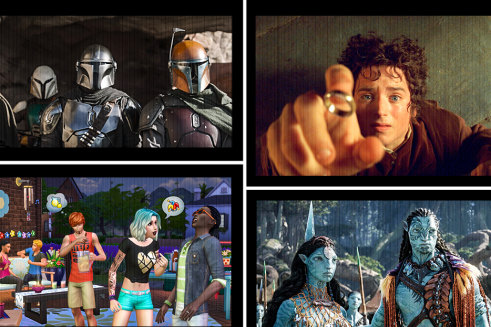Opinion
From Klingon to Elvish, what’s your favourite made-up language?
David Astle
Crossword compiler and ABC Radio Melbourne presenterYoung John fell in love with the coal trains clinking through Birmingham. Less the rolling stock than the mystery words on each carriage, incantations like Nantyglo and Senghenydd. Mix those with classical Greek, which the boy learnt at 11, plus the meter of Old English, and Tolkien was destined to conlang.
Construct a new language, in other words. Make new words, in other words. Other tongues, too, from Elvish to Dwarvish. Add a splash of Old Norse into the recipe, the Icelandic sagas, and soon Middle-earth was taking shape, word by invented word.

Sometimes it’s words that help make make-believe more believable. Clockwise from left: The Mandalorian, The Lord of the Rings, Avatar and The Sims.Credit:
Yet even before academia, J. R. R. was dabbling in DIY languages. Stuff like Novbosh (the new nonsense, he called it) or Fonwegian, a loose Scandi-salad. By the time The Hobbit surfaced in 1937, Tolkien’s gift for imaginary glossaries was luminous. Those old coal cars now carried whole kingdoms.
Conlangs bear such power, the knack to whisk you elsewhere, be that Essos in Game of Thrones (via Dothraki) or remote planets. Eavesdrop Na’vi from Avatar, say, and you’re mentally landing on Pandora, the realm its blue residents call Eywa’eveng.
All week I’ve succumbed to such fanciful linguistics, from Pinguish (Pingu’s meaningful squeaks) to banana language (the Minions’ mishmash), hearing how a donkey’s lonesome cry in Tunisia went to elongate the vowels of Mando’a – the speech of The Mandalorian. Or how dolphin trills and chafed parsnips contributed to the click-speak shared by the “prawnie” aliens in District 9.
A fluent Klingon speaker, Yens Wahlgren is the author of The Universal Translator (History Press, 2021), the subtitle promising: “Everything you need to know about 139 languages that don’t really exist.” But, of course, they do. Exist, I mean. Just as Swedish, Wahlgren’s birth language is as legit as the evolving sophistication of Gallifreyan (Dr Who’s language), or the singsong vocab of Simlish, where kik is kiss, and wabadebadoo announces “I’m on fire”.
As a xenosociolinguist (a mouthful meaning “a professor of strange-world words”), Wahlgren devotes hours to Tintin (the Balkan-ish Syldavian of The Calculus Affair, the Cockney-Strine of Arumbaya in The Broken Ear), plus the joys of Shyriiwook in Star Wars.
Earthly history, too, from Hildegard of Bingen’s “lingua ignota” that encoded medieval lore, or the severe ambitions of John Wilkins, who in 1688 dismantled English into 40 categories (from di – stone, to za – fish) in a bid to expunge our messy ambiguity.
Wahlgren’s own passion is rooted in an Italian cartoon series of the early ’70s. All silhouette, La Linea traces a man walking a pencilled line, meeting obstacles or animals en route, constantly mumbling his cranky grammelot, the conlang forged by Renaissance jesters, a non-verbal vocab made to engage a foreign audience.
Compare that simplicity with the Fremen commentary we hear in the Dune franchise, Frank Herbert’s cocktail of Arabic, Serbian and a spell book of Romani sorcery. While Wahlgren’s conlang census isn’t a page-turner, it turns your head to the human talent for building worlds via words, the verse behind a universe.
Just to learn, Avatar director James Cameron had selected te reo Maori to underpin Na’vi, only to need a conlang expert to extend the glossary. Linguist Paul Fromm stepped in, building syntax, idiom, plus a base-eight numbering system to honour the Na’vi’s four-fingered paws. Shazam! Or zazam at least, Na’vi for 4096.
Whichever your epic, from Smurfs to Sims, from Asterix to Arrival, from Star Wars to Star Trek, a conlang is often the key ingredient to make the make-believe believable.
To read more from Spectrum, visit our page here.
For subscribers: Get tips, tricks and word games from our crosswords guru, plus links to our online puzzles and quizzes, delivered to your inbox every Saturday. Sign up for our Puzzled with David Astle newsletter.